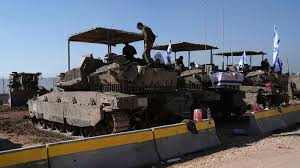Israel-Hamas Ceasefire

- 19 Jan 2025
In News:
After 15 months of war triggered by Hamas' October 2023 attack on Israel, a ceasefire agreement has been brokered by Qatar, Egypt, and the US, marking a fragile but significant pause in one of the most destructive phases of the Israel-Palestine conflict.
Key Features of the Ceasefire Agreement
The agreement is based on a three-phase framework proposed by US President Joe Biden in June 2024 and endorsed by the UN Security Council:
Phase I (42 days)
- Complete ceasefire and withdrawal of Israeli forces from all populated areas in Gaza.
- Release of 33 Israeli hostages (women, elderly, injured) by Hamas.
- Release of 900–1,650 Palestinian prisoners, including minors and those detained since October 7, 2023.
- Daily entry of 600 humanitarian aid trucks into Gaza.
- Partial Israeli withdrawal from key corridors like Netzarim (splitting Gaza) and parts of the Philadelphi Corridor (Gaza-Egypt border).
Phase II
- Release of remaining hostages, primarily male soldiers.
- Complete Israeli military withdrawal from Gaza.
- Details to be negotiated during Phase I; no written guarantees for its execution.
Phase III
- Return of the remains of deceased hostages.
- Initiation of a multi-year reconstruction plan for Gaza under international supervision.
Challenges to Implementation
Fragile Political Consensus in Israel
- Far-right ministers (e.g., Itamar Ben-Gvir) oppose the deal, threatening to quit the government.
- Prime Minister Netanyahu faces pressure from both hawks demanding a full military victory and moderates seeking peace.
Hamas' Demands
- Seeks permanent ceasefire and complete Israeli withdrawal, making it unwilling to release all hostages without guarantees.
- Israel, in contrast, insists on neutralizing Hamas militarily.
Unclear Future Governance of Gaza
- Israel rejects both Hamas and the Palestinian Authority (PA) as future administrators.
- Global consensus supports Palestinian-led governance, but viable alternatives remain elusive.
Wider Geopolitical Impact
Reshaping West Asia
- Conflict escalated tensions with Hezbollah (Lebanon) and drew Israel into direct conflict with Iran.
- Iran’s influence weakened due to losses in Hezbollah and Syria.
- Assad regime in Syria collapsed, altering regional power dynamics.
Diplomatic Repercussions for Israel
- Despite military dominance, Israel faces global condemnation over civilian casualties.
- PM Netanyahu is under scrutiny at the ICC (war crimes) and ICJ (genocide allegations).
- Israel is now diplomatically isolated, particularly after the humanitarian toll in Gaza.
Humanitarian Crisis in Gaza
- Over 64,000 Palestinians killed (The Lancet, 2024), including large numbers of civilians.
- Massive destruction of infrastructure—schools, hospitals, homes—rendering Gaza nearly uninhabitable.
- Reconstruction hinges on sustained peace and international aid.
Conclusion
The ceasefire presents a rare opportunity for de-escalation in a deeply entrenched conflict. However, distrust between parties, domestic political constraints, and regional rivalries pose significant risks to its sustainability. A durable peace can only emerge through inclusive political dialogue, humanitarian prioritization, and movement toward a two-state solution.
